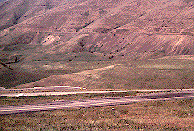
This conflict was the first major battle of the Nez Perce War.
Though outnumbered two to one the Nez Perce managed to kill one third of Howard's force and rout the rest of them.
 |
|||
| Look down into White Bird Canyon, where Chef Jospeph was encamped with his people in 1873 when told by General Howard they had 30 days to move to the Lapwai reservation. This conflict was the first major battle of the Nez Perce War. Though outnumbered two to one the Nez Perce managed to kill one third of Howard's force and rout the rest of them. |
Five warriors ... had been sent out from the other [west] side of the valley as a peace party to meet the soldiers. These warriors had instructions from the chiefs not to fire unless fired upon. Of course they carried a white flag. Peace might be made without fighting....
From the north echoed a rifle report, and right away a white man on a white horse came riding swiftly south.... He did not look like a soldier. A big white hat, he was dressed more like a citizen. When he came closer, we knew him.... It was Chapman, called by the whites a squaw man! Having an Indian wife was why he had been friends. He and my uncle, Old Yellow Wolf, had lived in the same house, just as brothers. Now he was the first enemy we see. Changed, and trying to kill each other. It was he who fired the first shot we had just heard. Fired on our peace party.
Yellow Wolf
Several, maybe twenty, soldiers followed close after Chapman. There was a bugler and when the party all stopped, this bugler rode a little ahead of them. He began calling orders on his trumpet. Otstotpoo [Fire Body] said to me, 'You now watch! I will make a good shot and kill that bugler!'
He did make the long-distance shot, and dead dropped the bugler from his horse. Chapman and his soldiers whirled and rode rapidly away from there ... It was good to get the bugler who called the General's orders to his fighting soldiers.
Two Moons
One bugler was dead, and the other one could not find his trumpet. With no means of communication with the troops, confusion reigned among the soldiers.